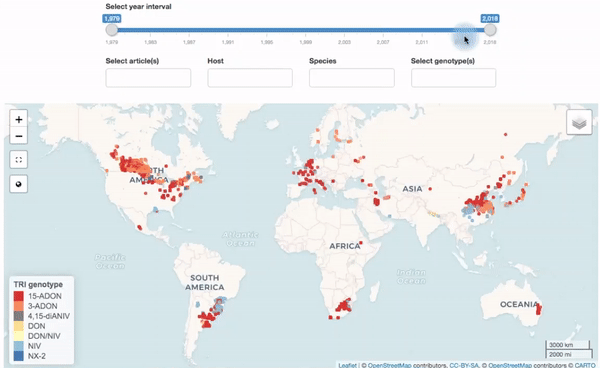Background
Members of the Fusarium graminearum species complex (FGSC), an ascomycete fungus, rank among the most dangerous plant pathogens worldwide.
These mycotoxigenic fungi affect mainly small grain crops such as wheat and barley, but also maize, rice and other important cereal crops.
During the first decade of 2000, employing multilocus sequencing of global collections of strains that were morphologically defined as a single panmictic species previously known as “Fusarium graminearum”, 16 species have been described (K. O’Donnell et al. 2000; Kerry O’Donnell et al. 2004, 2008; Starkey et al. 2007; Yli-Mattila et al. 2009; Sarver et al. 2011).
Since then, researchers from all over the world have been surveying cereal crops and identifying these newly discovered phylogenetic species and associated toxin profile using molecular tools (Backhouse 2014; van der Lee et al. 2015; AOKI et al. 2012).
An European database of chemotypes has been developed (Pasquali et al. 2016).
What is the database for?
FGSCdb is an open database of characterized FGSC strains whose data have been gathered directly from researchers or extracted from peer-reviewed articles whenever the geographic, host of origin, year, and phylogenetic species (and associated trichothecene chemotype/genotype whenever available) information are available in the main text or supplemental material of the publication.
The project was developed as supplemental material for a systematic review article to be submitted soon for publication (Del Ponte et al. unpublished).
How is it developed?
The database is organized in a Google Sheet, an online spreadsheet that facilitates shared work and collaboration.
Scripts to gather the data and prepare grid, plot and map visualizations were developed using several R packages including crosstalk for adding interactivity in the grid and map view.
The main packages used were leaflet for maps, datatable for grid view and plotly for dynamic plotting.
The website is constructed using the distill R package.
The raw data can be downloaded in PDF or excel format.
What’s next?
We would like to extend the utility of this project by allowing other researches to contribute data to populate the global map.
Get in touch (delponte@ufv.br) to receive instructions on how to submit your data.

Project website: fgsc.netlify.app
Data source: github.com/emdelponte/FGSC
Author and maintainer: Emerson M. Del Ponte
Maintainer: Gláucia M. Moreira
Current collaborators (raw data): Camila P. Nicolli, Todd J. Ward, Cees Waalwijk, Theo van der Lee, Kerry O’Donnell, Sofia N. Chulze, Sebastian A. Steinglein, Dinorah Pan, Silvana Vero, Hao Zhang, Dauri J. Tessmann, Lisa J. Vaillancourt, Antonio Moretti, Antonio Logrieco
AOKI, Takayuki, Todd J. WARD, H. Corby KISTLER, and Kerry O’DONNELL. 2012.
“Systematics, Phylogeny and Trichothecene Mycotoxin Potential of Fusarium Head Blight Cereal Pathogens.” Mycotoxins 62 (2): 91–102.
https://doi.org/10.2520/myco.62.91.
Backhouse, David. 2014.
“Global Distribution of Fusarium Graminearum, F. Asiaticum and F. Boothii from Wheat in Relation to Climate.” European Journal of Plant Pathology 139 (1): 161–73.
https://doi.org/10.1007/s10658-013-0374-5.
O’Donnell, Kerry, Todd J. Ward, Dereje Aberra, H. Corby Kistler, Takayuki Aoki, Nathane Orwig, Makoto Kimura, Åsmund Bjørnstad, and Sonja S. Klemsdal. 2008.
“Multilocus Genotyping and Molecular Phylogenetics Resolve a Novel Head Blight Pathogen Within the Fusarium Graminearum Species Complex from Ethiopia.” Fungal Genetics and Biology 45 (11): 1514–22.
https://doi.org/10.1016/j.fgb.2008.09.002.
O’Donnell, Kerry, Todd J. Ward, David M. Geiser, H. Corby Kistler, and Takayuki Aoki. 2004.
“Genealogical Concordance Between the Mating Type Locus and Seven Other Nuclear Genes Supports Formal Recognition of Nine Phylogenetically Distinct Species Within the Fusarium Graminearum Clade.” Fungal Genetics and Biology 41 (6): 600–623.
https://doi.org/10.1016/j.fgb.2004.03.003.
O’Donnell, K., H. C. Kistler, B. K. Tacke, and H. H. Casper. 2000.
“Gene Genealogies Reveal Global Phylogeographic Structure and Reproductive Isolation Among Lineages of Fusarium Graminearum, the Fungus Causing Wheat Scab.” Proceedings of the National Academy of Sciences 97 (14): 7905–10.
https://doi.org/10.1073/pnas.130193297.
Pasquali, Matias, Marco Beyer, Antonio Logrieco, Kris Audenaert, Virgilio Balmas, Ryan Basler, Anne-Laure Boutigny, et al. 2016.
“A European Database of Fusarium Graminearum and f. Culmorum Trichothecene Genotypes.” Frontiers in Microbiology 7 (April).
https://doi.org/10.3389/fmicb.2016.00406.
Sarver, Brice A.J., Todd J. Ward, Liane R. Gale, Karen Broz, H. Corby Kistler, Takayuki Aoki, Paul Nicholson, Jon Carter, and Kerry O’Donnell. 2011.
“Novel Fusarium Head Blight Pathogens from Nepal and Louisiana Revealed by Multilocus Genealogical Concordance.” Fungal Genetics and Biology 48 (12): 1096–1107.
https://doi.org/10.1016/j.fgb.2011.09.002.
Starkey, David E., Todd J. Ward, Takayuki Aoki, Liane R. Gale, H. Corby Kistler, David M. Geiser, Haruhisa Suga, Beáta Tóth, János Varga, and Kerry O’Donnell. 2007.
“Global Molecular Surveillance Reveals Novel Fusarium Head Blight Species and Trichothecene Toxin Diversity.” Fungal Genetics and Biology 44 (11): 1191–1204.
https://doi.org/10.1016/j.fgb.2007.03.001.
van der Lee, Theo, Hao Zhang, Anne van Diepeningen, and Cees Waalwijk. 2015.
“Biogeography ofFusarium Graminearumspecies Complex and Chemotypes: A Review.” Food Additives & Contaminants: Part A 32 (4): 453–60.
https://doi.org/10.1080/19440049.2014.984244.
Yli-Mattila, Tapani, Tatiana Gagkaeva, Todd J. Ward, Takayuki Aoki, H. Corby Kistler, and Kerry O’Donnell. 2009.
“A Novel Asian Clade Within the Fusarium Graminearum Species Complex Includes a Newly Discovered Cereal Head Blight Pathogen from the Russian Far East.” Mycologia 101 (6): 841–52.
https://doi.org/10.3852/08-217.
